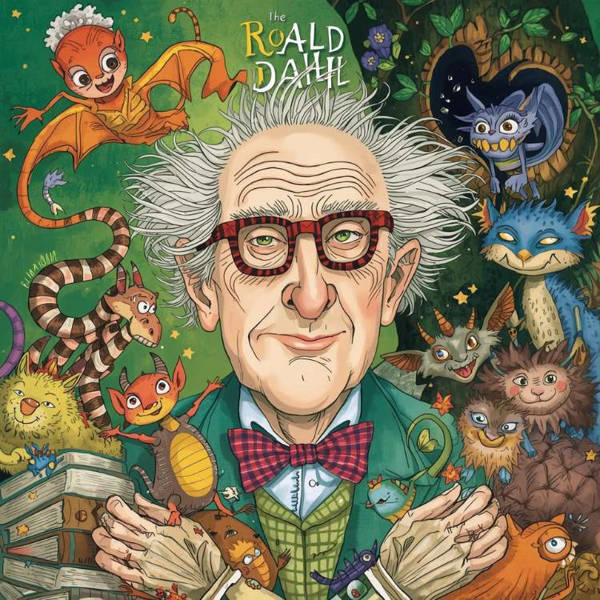
A Master of Imagination and Mischief
Few authors have left such an unforgettable mark on the world of children’s literature as Roald Dahl. His books are full of wonder, humor, and magic — but also shadows. In every story, beneath the laughter and fantasy, there lies something darker: cruelty, revenge, and the triumph of cleverness over tyranny.
From Charlie and the Chocolate Factory 🍫 to Matilda 📖 and The BFG 👣, Dahl’s characters face cruel adults, absurd systems, and impossible odds — and yet they always find a way to win. His unique blend of charm and darkness transformed storytelling for young readers and made him one of the most influential authors of the 20th century.
This article explores who Roald Dahl was, how his life shaped his fiction, and why his stories continue to enchant and unsettle readers today.
Early Life: From Norway to Wales and the Seeds of Imagination
Roald Dahl was born on September 13, 1916, in Llandaff, Wales, to Norwegian immigrant parents, Harald Dahl and Sofie Magdalene Hesselberg. His father, a successful shipbroker, and his mother, a devoted homemaker, instilled in him a deep love of Norwegian folklore and adventure stories. Every summer, the family traveled to Norway, where Dahl absorbed the legends of trolls and magical creatures — influences that would later color his writing. 🇳🇴✨
Tragedy struck early. When Dahl was just three years old, his sister Astri died of appendicitis, and shortly afterward, his father passed away from pneumonia. Despite these losses, Dahl’s mother decided to stay in Wales to honor her husband’s wish that their children receive a British education.
Boarding School Days: The Cruelty Behind the Creativity
Dahl’s school years were marked by both discipline and rebellion. He attended Llandaff Cathedral School and later Repton School, two prestigious but harsh English institutions. The strict teachers and bullying prefects left deep emotional scars — yet they also inspired some of his most memorable villains.
Characters like Miss Trunchbull in Matilda and the Headmaster in The Witches were not just fictional exaggerations; they were reflections of real figures Dahl encountered. In his autobiography Boy: Tales of Childhood, he vividly describes being beaten for minor mischiefs and witnessing acts of injustice that would later fuel his passion for empowering children through stories.
Interestingly, while at Repton, Dahl and his classmates were occasionally sent chocolate bars by Cadbury to taste-test new products. This experience planted the seed for his most famous creation — Willy Wonka’s chocolate factory. 🍫✨
A War Hero’s Journey: The Making of a Storyteller
After finishing school, Dahl chose adventure over university. In 1934, he joined Shell Oil Company, which sent him to East Africa. But with the outbreak of World War II, his life took a dramatic turn.
In 1939, Dahl enlisted in the Royal Air Force (RAF), where he became a fighter pilot. During a mission in Libya, his plane crash-landed in the desert, leaving him with severe injuries and lifelong back pain. After recovering, he continued serving until medical issues forced him to retire from flying.
He was then assigned to Washington, D.C., as part of British intelligence — a real-life spy role that introduced him to diplomacy, intrigue, and famous figures of the time. These experiences inspired his later work in espionage fiction, especially his James Bond-like stories in Someone Like You and Kiss Kiss.
The Birth of a Writer ✍️
Dahl’s writing career began almost by accident. While in Washington, he met the writer C.S. Forester (creator of Horatio Hornblower), who encouraged him to share his wartime experiences. Dahl’s first published story, Shot Down Over Libya (later retitled A Piece of Cake), appeared in The Saturday Evening Post in 1942 — and from that moment, a new career took flight.
His early works focused on adults, exploring irony, betrayal, and human weakness — themes that would later reappear in his children’s books, but softened by humor and fantasy. However, it wasn’t until he became a father that he truly discovered his talent for writing for young readers.
The Transition to Children’s Literature 👶📚
In the 1950s, Dahl married Patricia Neal, an American actress, and together they had five children. The family’s life was filled with both joy and tragedy. Their son Theo suffered a brain injury in an accident, and their daughter Olivia died of measles at age seven — a loss that profoundly affected Dahl.
To entertain his surviving children, he began inventing bedtime stories full of absurd humor, villains, and courage. These tales evolved into published books, beginning with James and the Giant Peach (1961). The book’s blend of grotesque characters, talking insects, and an orphan boy’s adventure captivated readers and marked the beginning of Dahl’s golden era.
The Golden Age of Roald Dahl’s Works 🌟
Throughout the 1960s, 70s, and 80s, Dahl produced some of the most beloved — and most subversive — stories in children’s literature. His books stood out because they refused to talk down to children. Instead, they treated young readers as clever, capable, and morally aware.
Here are some of his most iconic works:
1. Charlie and the Chocolate Factory (1964) 🍭
Arguably Dahl’s most famous book, it tells the story of Charlie Bucket, a poor boy who wins a golden ticket to visit Willy Wonka’s magical chocolate factory. Beneath its colorful surface, the story explores greed, consumerism, and justice — with naughty children receiving bizarre punishments that mirror their flaws.
2. Fantastic Mr. Fox (1970) 🦊
A clever fox outsmarts three mean farmers in this witty tale about survival and cunning. Dahl celebrates intelligence over brute force, making it a story of resilience and rebellion.
3. Danny, the Champion of the World (1975) 🚗
Perhaps one of his most heartfelt stories, it portrays a father-son bond rooted in love and mischief. It’s a quieter, more emotional side of Dahl that balances his darker works.
4. The BFG (1982) 👣
The Big Friendly Giant is both funny and heartwarming, blending dreams, courage, and friendship. It reveals Dahl’s gentler imagination while still hinting at danger and fear.
5. The Witches (1983) 🧙♀️
One of Dahl’s darkest children’s books, it features a secret society of witches who hate children. The story balances terror and humor masterfully — a hallmark of Dahl’s style.
6. Matilda (1988) 📖
A masterpiece about intelligence, kindness, and justice. Matilda celebrates a gifted girl who uses her wit and powers to stand up against cruel adults, especially the terrifying Miss Trunchbull. It remains one of the most empowering stories ever written for young readers.
A Dark Sense of Humor and a Sharp Moral Vision
What makes Dahl’s stories unforgettable is their tone. They are never simply cheerful or moralizing. Instead, they present the world as dangerous but conquerable. Adults are often villains — greedy, stupid, or cruel — while children are clever, brave, and kind.
This inversion of traditional authority appealed deeply to young readers. Dahl understood that childhood is not all innocence; it’s a struggle to navigate unfairness. His humor, often macabre, served as a coping mechanism — transforming fear into laughter.
At the same time, his stories carried a clear moral code: kindness and courage win, greed and cruelty fail. Despite their darkness, his tales always end with hope. 🌈
Roald Dahl the Man: Controversy and Complexity
While his books continue to delight millions, Dahl himself was a complicated figure. Known for his sharp tongue and strong opinions, he sometimes made remarks that sparked controversy — particularly later in life. In recent years, debates have arisen about how to interpret his legacy.
Publishers have even revised some of his texts to remove or alter language considered offensive by modern standards, sparking discussions about censorship, intent, and artistic freedom. Many scholars and readers, however, argue that Dahl’s works should be understood in their historical context, as reflections of the time and personality that created them.
Legacy: The Enduring Power of Imagination 🌍
Roald Dahl died on November 23, 1990, at the age of 74, in Oxford, England. But his imagination lives on — not only through his books but also through their countless adaptations in film, theater, and music.
Movies like Willy Wonka & the Chocolate Factory (1971), Matilda (1996), The BFG (2016), and Charlie and the Chocolate Factory (2005) have introduced his stories to new generations. His works continue to sell millions of copies each year and are translated into more than 60 languages.
Beyond entertainment, Dahl’s influence extends into education and psychology. His books encourage critical thinking, moral reflection, and creative resilience. They remind readers that even in dark times, imagination can be a weapon — and laughter, a form of resistance.
Conclusion: The Genius of Dark Delight
Roald Dahl’s legacy lies in his extraordinary ability to blend light and darkness — to write stories that are both funny and frightening, cruel and kind. His worlds remind us that childhood is not about avoiding fear but overcoming it.
He once wrote, “Those who don’t believe in magic will never find it.” That spirit of curiosity, courage, and mischief continues to make his work timeless. ✨
In every story, Dahl invites readers to face the world’s absurdities with laughter, intelligence, and imagination — and that is what makes him not just a great children’s author, but a great human storyteller.
Sources:
- The Roald Dahl Museum and Story Centre (Official)
- BBC Arts & Culture – “Roald Dahl: The Storyteller Who Never Grew Up”
- The Guardian – “Reassessing Roald Dahl’s Legacy” (2023)
- Biography.com – “Roald Dahl Biography”
- Penguin Books – “The Life of Roald Dahl”
- National Centre for Children’s Literature (UK)

